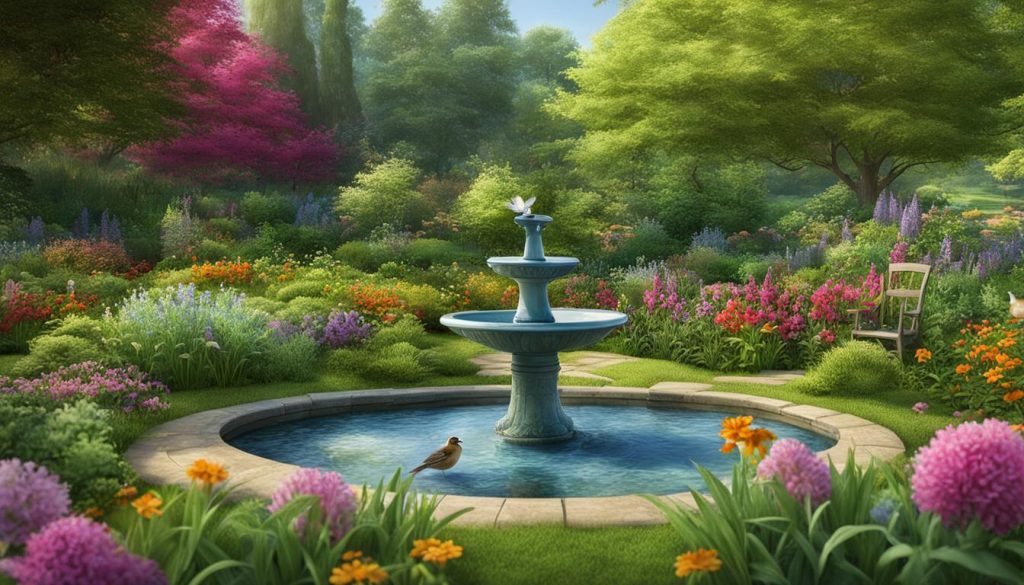
Creating a Haven: How to Attract Wildlife to Your Garden
Attracting wildlife to your garden is a rewarding and worthwhile endeavor. By providing the necessary food and shelter, you can create a haven for a wide range of creatures, from bees and butterflies to birds and small mammals. In this article, I will share top tips and strategies to help you make your garden a wildlife-friendly oasis.
Key Takeaways
- Creating a wildlife-friendly garden is a rewarding and enjoyable experience.
- Implementing the tips and strategies mentioned in this article can attract a diverse array of wildlife to your garden.
- Providing the necessary food, water, and shelter contributes to the conservation of garden biodiversity.
- Enjoy the sights and sounds of wildlife right in your own backyard.
- You can make a positive difference for wildlife in the United Kingdom.
Grow Wild
One of the best ways to attract wildlife to your garden is by allowing nature to take its course. Consider dedicating a small corner, border, or planter to wildflowers. Native wildflowers like forget-me-nots, red campions, foxgloves, and chamomile not only provide a stunning display but also serve as a valuable nectar source for bees and butterflies. By choosing the right species, you can even grow flowers that attract insects, which in turn become a food source for birds or bats.
Additionally, consider adopting a more natural approach to your lawn by allowing plants like daisies, clover, and buttercups to grow. These “weeds” offer food, shelter, and breeding grounds for insects, which are crucial for birds and small mammals like hedgehogs.
| Native Wildflowers | Nectar Source | Attracts |
|---|---|---|
| Forget-me-nots | Bees, butterflies | Insects, birds |
| Red campions | Bees, butterflies | Insects, birds |
| Foxgloves | Bees, butterflies | Insects, birds |
| Chamomile | Bees, butterflies | Insects, birds |
By incorporating these native wildflowers into your garden, you can create a vibrant and thriving ecosystem that supports a wide variety of wildlife. The colorful blooms will not only enhance the visual appeal of your garden but also provide a vital source of food and shelter for bees, butterflies, insects, and birds. Letting nature grow wild in your garden is a simple yet effective way to attract and support wildlife.
The Benefits of Lawn Biodiversity
In addition to growing wildflowers, adopting a more natural approach to your lawn can greatly benefit wildlife. Instead of striving for a perfectly manicured lawn, allow grasses and flowers to grow a little longer. This provides easy access to food sources, such as worms, for various creatures and creates a microclimate under the stalks, offering shelter and protection.
Embrace so-called “weeds” like dandelions, nettles, and thistles, as they serve as important food sources for various caterpillars and insects. These insects, in turn, become a valuable food source for birds and bats. By letting things grow a little wild, you are providing a diverse range of habitats within your garden, attracting a wide array of wildlife.
Creating a wildlife-friendly garden is not only beneficial for the environment but also a joy to experience. The sight of colorful wildflowers attracting bees and butterflies, the sound of birdsong, and the opportunity to observe the fascinating behavior of wildlife up close can bring a sense of tranquility and connection with nature right to your doorstep.
Plant Trees and Shrubs
Research has shown that gardens with trees are more attractive to wildlife. By planting wildlife-friendly trees and shrubs, you can provide not only food and habitat but also a range of additional benefits, such as noise reduction and climate change mitigation.
Consider trees like silver birch, which provides food and habitat for over 300 insect species and is a source of food for birds. Wild cherry produces flowers, fruits, and leaves that feed various bees, caterpillars, birds, and mammals. For smaller spaces, trees like dogwood and dog rose offer food for insects, mammals, and birds. Choose native species that are suitable for your garden size and location.
Benefits of Planting Trees and Shrubs:
- Provides food and habitat for insects, birds, and mammals.
- Reduces noise pollution and absorbs carbon dioxide.
- Creates a natural and visually appealing landscape.
- Supports biodiversity and promotes a healthy ecosystem.
“Planting trees not only benefits wildlife but also improves the overall quality of the environment. By incorporating wildlife-friendly trees and shrubs into your garden, you are contributing to the conservation of biodiversity and creating a more sustainable habitat for various species.” – Wildlife Gardening Expert
To further enhance the wildlife appeal of your garden, consider planting a mix of trees and shrubs that provide different types of food and shelter throughout the year. This will attract a diverse range of insects, birds, and mammals, creating a thriving ecosystem right in your backyard.
| Tree Species | Benefits |
|---|---|
| Silver Birch | Food and habitat for over 300 insect species. Source of food for birds. |
| Wild Cherry | Flowers, fruits, and leaves that feed bees, caterpillars, birds, and mammals. |
| Dogwood | Provides food for insects, mammals, and birds. |
| Dog Rose | Offers food for insects, mammals, and birds. |
Create a Ready-Made Cozy Home
Creating a wildlife-friendly garden involves more than just providing food and water. It’s important to create suitable habitats where different species can thrive. By installing ready-made homes like bird boxes, bug hotels, frog pots, and hedgehog houses, you can attract specific wildlife to your garden and provide them with a cozy place to call home.
Bird boxes are designed to mimic natural nesting sites and provide shelter for a variety of bird species. They can be placed on trees, walls, or posts, and should be positioned away from direct sunlight and prevailing winds. Bug hotels are a great way to attract beneficial insects like ladybugs and lacewings, which help control garden pests. These hotels can be made by stacking materials such as bamboo canes, hollow plant stems, and pine cones in a wooden frame.
“Bug hotels are like luxury apartments for insects, providing them with a safe place to rest, breed, and hibernate,” says Dr. Jane Smith, a wildlife expert.
Frog pots or small ponds are perfect for attracting amphibians to your garden. They can be as simple as a shallow container filled with water and plants or a more elaborate pond with a shallow sloping edge. Amphibians like frogs and toads will appreciate the water source for breeding and as a place to find food and shelter. Hedgehog houses are designed specifically for these spiky little creatures. They provide a safe and warm place for hedgehogs to hibernate during the winter months and raise their young in the spring.
By providing these ready-made homes, you not only enhance the biodiversity of your garden but also create opportunities for observation and interaction with the wildlife that calls your garden home. So, whether it’s bird boxes, bug hotels, frog pots, or hedgehog houses, these animal habitats are a wonderful addition to any wildlife-friendly garden.
Comparison of Ready-Made Animal Homes
| Animal Habitat | Features | Benefits |
|---|---|---|
| Bird Boxes | Wooden boxes with entrance holes and nesting chambers | Provides shelter and nesting sites for a variety of bird species |
| Bug Hotels | Stacked materials like bamboo canes, hollow plant stems, and pine cones | Attracts beneficial insects that control garden pests |
| Frog Pots | Shallow containers filled with water and plants | Provides a water source and habitat for amphibians |
| Hedgehog Houses | Specialized shelters designed for hedgehogs | Offers a safe and warm place for hibernation and raising young |
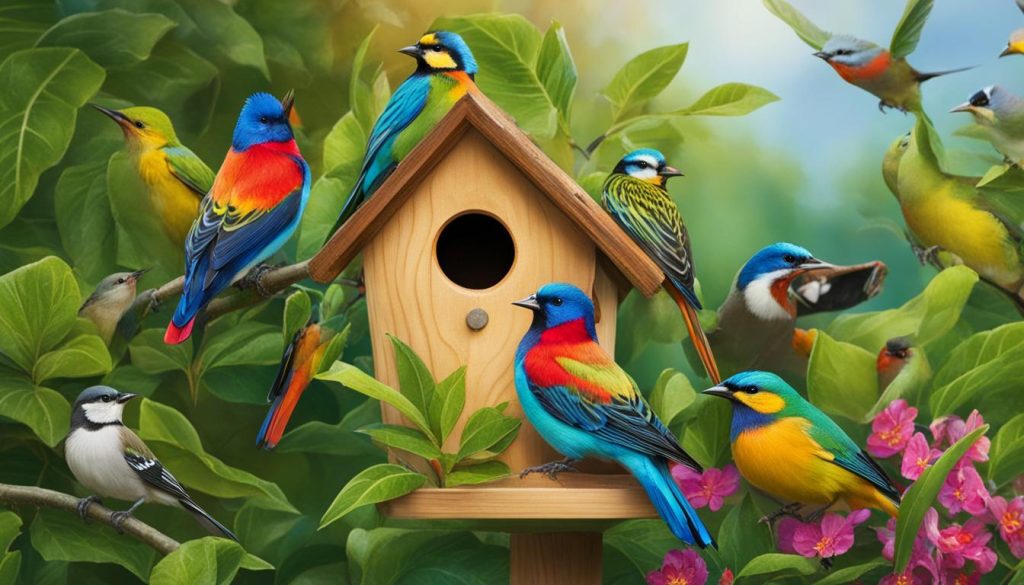
Offer a Water Source
Water is vital for wildlife, providing them with a source of hydration and bathing. By offering a water source in your garden, you can attract a diverse range of creatures and create a thriving ecosystem. Even a small dish of water can provide a lifeline for birds and mammals, supplying them with the essential fluids they need to survive. Additionally, a small pond can serve as a habitat for insects and amphibians, further enhancing the biodiversity in your garden.
To cater to different species, it is important to provide various entry points for easy access and escape. This can be achieved by creating shallow areas or adding rocks and logs to your pond. It’s essential to keep the water clean and regularly topped up, especially during dry periods. By offering a reliable water source, you can support wildlife throughout the year and enjoy the delightful sight of birds bathing or frogs hopping around.
Creating a Wildlife-Friendly Pond
If space permits, consider creating a small pond in your garden. Ponds are not only aesthetically pleasing, but they also provide a valuable habitat for a wide range of wildlife. To create a wildlife-friendly pond, follow these steps:
- Choose a suitable location: Select an area with partial shade to prevent water from overheating or excessive algae growth. Avoid placing the pond under trees, as falling leaves can cause water pollution.
- Dig the pond: Dig a hole of the desired shape and depth, ensuring there is a shallow area for creatures to access the water easily. Sloping sides and varied depths will cater to different species.
- Add rocks and plants: Arrange rocks around the edges of the pond to provide access points for animals. Plant native aquatic plants like water lilies and reeds to create hiding places and breeding sites.
- Fill the pond: Fill the pond with rainwater or tap water treated with a dechlorinator. Avoid using chemicals or fish, as they can disrupt the natural balance of the ecosystem.
- Wait for nature to take its course: Allow the pond to mature naturally, and soon you will see an array of creatures, such as dragonflies, water beetles, frogs, and even birds, visiting your pond.
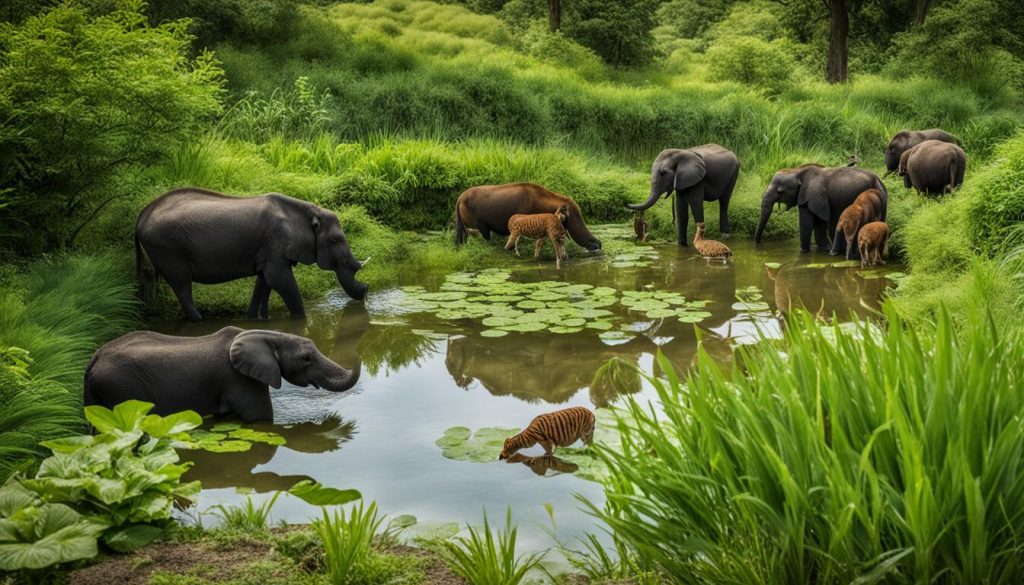
Serve an Extra Meal
Feeding wildlife in your garden is a wonderful way to attract a variety of creatures and provide them with essential nourishment. Putting out nuts and seeds can be particularly effective in attracting common birds such as goldfinches, blue tits, sparrows, blackbirds, and robins. These seeds are rich in nutrients and provide a valuable source of energy for birds throughout the year. Consider using a variety of feeders and scattering the seeds in different areas of your garden to accommodate different bird species.
Common Birds and Their Preferred Feed
| Bird Species | Preferred Feed |
|---|---|
| Goldfinch | Nyjer seeds, sunflower hearts |
| Blue Tit | Sunflower seeds, mealworms |
| Sparrow | Millet, mixed seeds |
| Blackbird | Fruit, mealworms |
| Robin | Mealworms, fruit |
In addition to nuts and seeds, you can provide mealworms as a special treat for certain mammals and birds. Mealworms are a great source of protein and are especially loved by badgers. You can also leave out fruit for foxes, which they find irresistible. Wet cat food and specialist kibble are ideal for feeding hedgehogs, who will appreciate the extra meal. However, it’s important to find a balance when feeding wildlife and not rely on human feeding as the only food source. Only feed wildlife occasionally, and keep an eye on who is eating the food to avoid unintended consequences.
Remember, feeding wildlife is a privilege and should be done responsibly. It’s important to provide a diverse range of foods, adapt to the dietary needs of different species, and ensure that the feeding areas are kept clean and hygienic. By offering an extra meal, you can create a welcoming environment for wildlife and enjoy the delightful sights and sounds of nature right in your own garden.
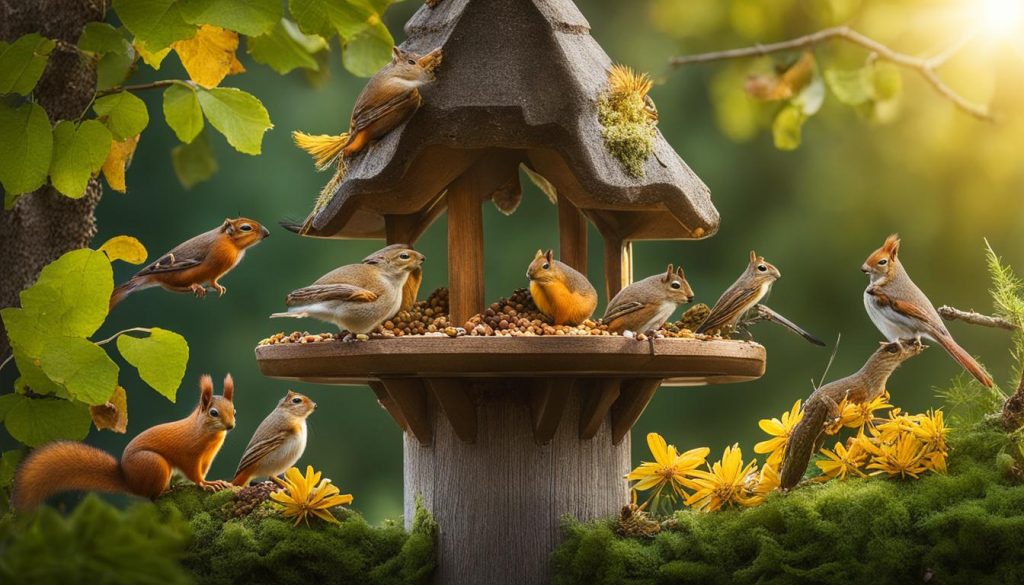
Did You Know?
“Feeding wildlife in your garden not only attracts them but also provides a valuable source of supplemental food, especially during harsh weather conditions or when natural food sources are scarce.”
Let Things Grow a Little Wild
When it comes to creating a wildlife-friendly garden, embracing a little wildness can go a long way. Instead of striving for a perfectly manicured lawn, consider allowing your grass to grow a bit longer. Longer grass provides shelter for various insects and creates a microclimate under the stalks. This microclimate becomes a haven for insects and invertebrates, which are crucial for the ecosystem of your garden.
Embrace so-called “weeds” like dandelions, nettles, and thistles. These plants are often seen as nuisances, but they actually serve as important food sources for various caterpillars and insects. By allowing these plants to thrive, you are providing essential nourishment for the wildlife in your garden. So, next time you spot a dandelion or a nettle, consider leaving it be and appreciating its contribution to the biodiversity of your garden.
In addition to embracing wildflowers and “weeds,” consider creating a small area dedicated to native wildflowers. These native plants not only provide a stunning display but also attract bees, butterflies, and other pollinators. They serve as valuable nectar sources and provide food for a wide range of insects. By incorporating these wildflowers into your garden, you are creating a diverse and vibrant habitat for wildlife.
Promoting Lawn Biodiversity
To visually showcase the benefits of letting things grow a little wild in your garden, below is a table highlighting the contrasts between a traditional manicured lawn and a wildlife-friendly lawn:
| Traditional Manicured Lawn | Wildlife-Friendly Lawn |
|---|---|
| Short grass length | Varied grass length |
| No wildflowers | Wildflowers blooming |
| Weed-free | Includes dandelions, nettles, thistles |
| Less food and shelter for insects and wildlife | Provides food and shelter for insects and wildlife |
As you can see, a wildlife-friendly lawn offers a more biodiverse and welcoming environment for wildlife. So, the next time you’re tempted to meticulously mow your lawn, consider allowing it to grow a little wild and embrace the beauty and benefits of a diverse ecosystem in your own backyard.
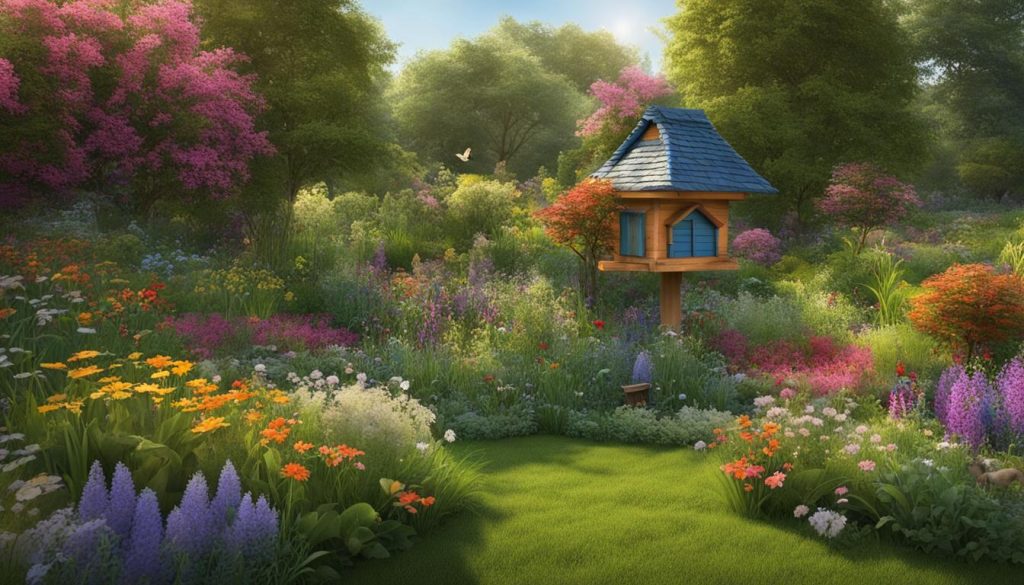
“In nature, nothing is perfect and everything is perfect. Trees can be contorted, bent in weird ways, and they’re still beautiful.” – Alice Walker
Conclusion
By letting things grow a little wild in your garden, you can create a haven for wildlife and contribute to the overall biodiversity of your local ecosystem. Embracing longer grass, native wildflowers, and so-called “weeds” like dandelions and nettles provides food, shelter, and habitat for a diverse range of insects, birds, and small mammals. So, release the reins of control a bit and allow nature to flourish in your garden. You’ll be rewarded with the sights and sounds of a thriving ecosystem right outside your door.
Conclusion
Creating a wildlife-friendly garden is a truly fulfilling experience. By implementing the tips and strategies I’ve shared in this article, you can attract a diverse array of wildlife to your garden, including bees, butterflies, birds, and small mammals.
By providing the necessary food, water, and shelter, you are not only creating a haven for nature but also contributing to the conservation of garden biodiversity. Your garden can become a thriving ecosystem where various species coexist and flourish, supporting the delicate balance of our natural world.
Imagine stepping outside into your garden and being greeted by the beautiful sights and sounds of nature. The buzzing of bees, the fluttering of butterfly wings, and the cheerful melodies of birds can all be enjoyed right in your own backyard. This wildlife-friendly oasis will not only bring you immense joy but also serve as a constant reminder of our connection to the natural world.
So, embrace the concept of wildlife-friendly gardening and make a positive difference for wildlife in the United Kingdom. Enjoy the wonders of nature and take pride in creating a haven where wildlife can thrive. Together, let’s celebrate the beauty of garden biodiversity and cherish the sights and sounds of nature in our own little piece of paradise.